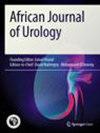Benign urinary bladder masses: rare entities
IF 0.4
Q4 UROLOGY & NEPHROLOGY
引用次数: 0
Abstract
Abstract Background This study aimed to present the characteristics and outcomes of benign urinary bladder masses, as well as the characteristics of the patients diagnosed with such lesions. Methods A single-center, cross-sectional, retrospective study was conducted. The study involved patients who underwent transurethral resection of the primary bladder tumor over a four-year period (May 2017–2021) and were subsequently diagnosed with a benign bladder lesion. Results Out of 478 patients who underwent transurethral resection of the primary bladder tumor, 26 (5.4%) were diagnosed with a benign bladder lesion. The most common benign bladder lesion was urothelial papilloma (50%, 13 patients). The majority of patients with urothelial papilloma were men (76.9%) and had a history of smoking (61.5%). The mean age was 62 years. Most were diagnosed accidentally (69.2%), while others presented with hematuria (23.1%) or dysuria (7.7%). Most urothelial papillomas had a macroscopic polypoid appearance (61.5%), and most of them were solitary (84.6%), with a mean size amounting to 1 cm. Only one patient experienced a recurrence and developed papillary urothelial neoplasm of low malignant potential (PUNLMP). Cystitis cystica/glandularis and polypoid cystitis were the second most commonly diagnosed benign bladder lesion, each identified in 3 patients. Singular cases of leiomyoma, inflammatory myofibroblastic tumor, chondroma, paraganglioma, villous adenoma, eosinophilic cystitis (pseudotumor), and ectopic prostatic tissue are described. Conclusion Benign bladder lesions constitute a group of various rare entities that can clinically and radiologically mimic urothelial carcinoma, but mostly show a good prognosis and a low incidence of recurrence.良性膀胱肿块:少见
背景本研究旨在介绍膀胱良性肿块的特点和预后,以及诊断为此类病变的患者的特点。方法采用单中心、横断面、回顾性研究。该研究涉及的患者在四年期间(2017年5月至2021年5月)接受经尿道原发性膀胱肿瘤切除术,随后被诊断为良性膀胱病变。结果478例经尿道膀胱原发肿瘤切除术患者中,26例(5.4%)诊断为膀胱良性病变。最常见的膀胱良性病变是尿路上皮乳头状瘤(50%,13例)。尿路上皮乳头状瘤患者以男性为主(76.9%),有吸烟史(61.5%)。平均年龄为62岁。大多数诊断为意外(69.2%),而其他人则表现为血尿(23.1%)或排尿困难(7.7%)。绝大多数尿路上皮乳头状瘤宏观表现为息肉样(61.5%),绝大多数为单发(84.6%),平均大小为1cm。只有一名患者复发并发展为低恶性潜能乳头状尿路上皮肿瘤(PUNLMP)。囊性/腺性膀胱炎和息肉样膀胱炎是第二常见的良性膀胱病变,各有3例。个别病例平滑肌瘤,炎性肌纤维母细胞瘤,软骨瘤,副神经节瘤,绒毛腺瘤,嗜酸性膀胱炎(假瘤),和异位前列腺组织的描述。结论膀胱良性病变是一组临床和影像学上与尿路上皮癌相似的罕见病变,但大多预后良好,复发率低。
本文章由计算机程序翻译,如有差异,请以英文原文为准。
求助全文
约1分钟内获得全文
求助全文

 求助内容:
求助内容: 应助结果提醒方式:
应助结果提醒方式:


